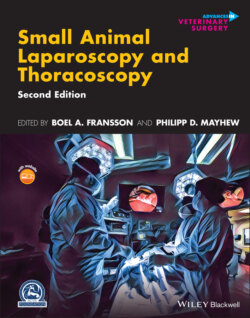Читать книгу Small Animal Laparoscopy and Thoracoscopy - Группа авторов - Страница 50
Suture Materials for Minimally Invasive Suturing Conventional Sutures
ОглавлениеConventional suture materials are routinely used in MIS, especially for interrupted sutures or ligatures. Braided synthetic absorbable sutures are often favored over monofilament synthetic absorbable sutures for intracorporeal suturing. The primary reason for this preference is the ease of handling that follows from the decreased memory of braided versus monofilament sutures. Furthermore, braided sutures are more resistant to instrument-induced damage during the knotting process. As knots are formed, there is significant interstrand friction, commonly known as chatter. This friction can induce significant damage to suture materials, particularly monofilaments. Braided materials are less vulnerable to this damage because their strength is distributed over many fibers similar to the cables of a suspension bridge. Braided materials are not without their downside, however. They have considerably more tissue drag than monofilament sutures, and they can harbor and potentiate bacterial infections. To minimize these effects, suture manufacturers have devised two solutions. First, application of coating agents, such as caprolactone and calcium stearate, fills in the gaps in the interstices of the braid and decreases friction during tissue passage. Second, some manufacturers use antimicrobial coatings on their materials to preemptively address suture-potentiated infections.
Figure 2.5 Double‐ligated cystic duct (A) and right ovarian pedicle (B) using 2 strands of 2‐0 polyglactin 910, with one double throw and two single throws. Use of a short suture strand, 15 cm or less, facilitates knot tying. Thus, using two separate strands may be more effective than to attempt two sutures with one longer strand. Laparoscopic knots tend to be weaker than openly tied, so the surgeon needs to take care to apply even and adequately high tension on the knots.
Knot security is a function of suture interstrand friction. Braided suture materials in general have a higher coefficient of friction than monofilament sutures. As such, braided sutures can form secure knots with fewer throws than monofilament sutures. However, knot security varies greatly between materials and sizes [7]. We have found one double throw (“Surgeon's throw”) and two single throws on 2‐0 polyglactin 910 to be safe for suture ligated ovarian pedicles and cholecystectomy (Figure 2.5), with two ligations per pedicle/bile duct. However, if the suture is not used for ligation but instead approximating tissues under tension, it is likely advisable to add one or two throws. Intracorporally tied knots tend to be weaker than knots tied by conventional open surgery [8]. This is true also for robotically tied knots [9]. Inappropriately tied knots can severely impact knot security. If tension is applied unequally or inadequately during tying, the knot may have gaps between throws, i.e. an air knot. Air knots further contribute to lack of knot security [10]. Therefore, the surgeon interested in using laparoscopic knot tying need to perfect his or her technique and take care to adequately tighten each throw when tying intracorporeal knots.
